Culture and Architecture in Slovakia’s Capital
Introduction
Nestled in Central Europe along the banks of the Danube River, Bratislava might not be the first city to come to mind when exploring this region. Yet Slovakia’s capital, located only 60 kilometres from Vienna and within reach of Budapest, offers a captivating blend of medieval charm, Habsburg history, and striking Soviet-era Brutalist architecture. While journeying from Vienna through Bratislava and onward to Budapest, I found Slovakia’s capital a unique highlight, offering its own contrasts and character that set it apart from its more famous neighbours.
This visit also marked a personal milestone. Bratislava was one of three new countries I explored on this trip, bringing me closer to my goal of visiting 70 countries by age 70. With its mix of old-world beauty and post-communist grit, Bratislava embodies the theme of contrasts. It is an ideal destination for those drawn to history and modern culture.
In this post, I’ll share my insights on Bratislava’s must-see sights. I’ll take you from the enchanting Old Town and imposing Soviet-era architecture to culinary gems showcasing the flavours of Slovakia. For culturally curious travellers, Bratislava is full of experiences. Its renowned landmarks and hidden corners reveal the depth and diversity of this often-overlooked city.

Bratislava’s Location
As Slovakia’s capital and westernmost city, Bratislava holds a distinctive position within Central Europe. Located near the borders of Austria and Hungary, it is one of only a few capitals in such close proximity to multiple neighbouring countries. This strategic location has historically made Bratislava a cultural crossroads, blending influences from across the region to shape the city’s dynamic identity. Bratislava is accessible by various transportation options. There are direct bus and train connections from Vienna, Budapest, and Prague, as well as a scenic ferry ride along the Danube from Vienna. Bratislava Airport is convenient for air travellers, and Vienna International Airport is only an hour away. Today, Bratislava is a microcosm of Central Europe’s layered history, cultural diversity, and evolving modernity. It is a compact yet enriching stop between larger cities.
Section I: Discovering Bratislava’s Old Town
Bratislava’s Old Town, or Staré Mesto, invites visitors into a world where medieval streets wind past pastel-coloured facades, Baroque details, and cozy cafés. This area captures Bratislava’s essence, blending its rich history with a lively modern-day atmosphere. The Old Town is the city’s historical and cultural heart. The area is perfect for travellers seeking an immersive experience in Slovakia’s capital, offering glimpses of the past alongside vibrant street life.


Highlights of Bratislava’s Old Town
Bratislava Castle
Atop a hill overlooking the Danube River, Bratislava Castle offers commanding views of the cityscape and beyond, even reaching Austria on clear days. The castle’s gleaming white walls and iconic red-tiled roof make it one of Bratislava’s most recognizable landmarks. The site is steeped in history, with roots stretching back to the Celtic and Roman periods. Today, it houses the Slovak National Museum, featuring Slovak history and culture exhibits. The panoramic views make the climb worthwhile, and visitors can also enjoy the castle’s gardens and explore its exhibitions.


St. Martin’s Cathedral
Near the base of the castle, St. Martin’s Cathedral stands as a Gothic masterpiece with historical significance. Once the coronation church for Hungarian kings and queens, it hosted nearly 300 years of royal ceremonies. Its tall spire is topped with a replica of the Hungarian crown, symbolizing its historical role. Inside, visitors can admire stained-glass windows, medieval carvings, and a sense of grandeur that reflects its royal past. Even if you don’t go inside, the cathedral’s exterior is an impressive sight in its own right.
Old Town Hall and Primate’s Palace
These landmarks showcase Bratislava’s architectural heritage and civic history. With its distinctive pastel colours, the Old Town Hall has served many purposes over the centuries, from a city hall to a mint. The Hall is now part of the Bratislava City Museum. It gives insight into the city’s past and offers visitors a chance to explore its history. Nearby, the neoclassical Primate’s Palace, with its famous Hall of Mirrors, was once the archbishop’s seat. Together, these buildings highlight the elegance and diversity of Bratislava’s architecture.


Michael’s Gate
As the only remaining gate from Bratislava’s medieval fortifications, Michael’s Gate holds significant historical importance. Its Gothic tower is topped with a statue of St. Michael slaying a dragon, a protective symbol. Beyond the gate, you’ll find narrow streets filled with shops, cafés, and street musicians, adding to the lively ambiance. For an added treat, climb the tower to view the Old Town’s rooftops from above—a photographer’s delight.

Grassalkovich Palace (Presidential Residence)
Known as Slovakia’s “White House,” Grassalkovich Palace is the president’s official residence. This Baroque palace is surrounded by well-tended gardens that are open to the public. It is a peaceful retreat for both locals and visitors. Though the palace itself isn’t open for tours, it’s a popular spot for photos and is often a venue for state functions. Its regal architecture stands as a symbol of Slovakian independence and governance.
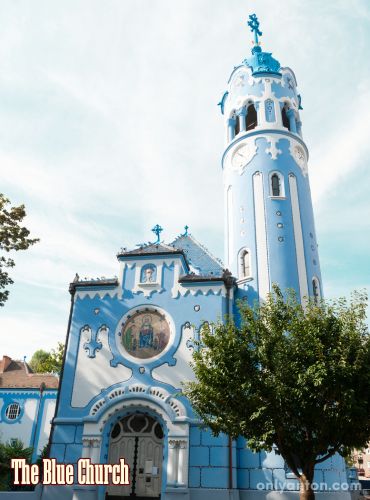
The Blue Church (Church of St. Elizabeth)
One of Bratislava’s most beloved landmarks, the Blue Church, is a stunning example of Art Nouveau architecture. Its vibrant blue facade, delicate white details, and overall whimsical design make it visually striking and memorable. The interior reflects the same delicate style, making it a must-visit for art enthusiasts and travellers alike. The church’s fairy-tale appearance stands out among Bratislava’s architectural gems and is an ideal spot for photography.
Personal Tips
Exploring Bratislava’s Old Town on foot is the best way to appreciate its charm fully. The narrow streets, hidden courtyards, and tucked-away statues reward those who wander. Take your time and explore beyond the main sights. You might discover unique local shops, intriguing street art, or quaint cafés perfect for a coffee break. The Old Town’s compact size makes it easy to cover on foot, allowing you to experience its atmosphere and appreciate the fine details that make this area special.
Section II: Exploring Soviet-Era Brutalist Architecture in Bratislava
Bratislava’s architecture tells a complex story; nowhere is this more evident than in its Soviet-era Brutalist buildings. Emerging after WWII, Brutalism became a dominant style across Eastern Europe, particularly in countries influenced by Soviet ideology. The term “Brutalism” derives from the French term béton brut, or “raw concrete.” The name reflects the emphasis on the raw, unadorned materials that are a hallmark of this style. Brutalism shares roots with the International Style, favouring functional, minimalist design over ornate decoration. However, International or Modernist styles tended to embrace lightness and glass. Soviet-era Brutalism focused on bold, heavy forms meant to symbolize strength and endurance. This style is particularly striking in Bratislava and reflects Slovakia’s complex history under Communist rule.
Highlights of Brutalist Architecture in Bratislava

The UFO Bridge (Most SNP)
A striking example of Soviet-era ambition is Bratislava’s UFO Bridge. This structure stands as a testament to bold Brutalist design and the architectural ideals of the period. Officially known as the Bridge of the Slovak National Uprising, it commemorates Slovakia’s 1944 resistance against Nazi forces. The bridge’s iconic, flying-saucer-shaped platform offers a panoramic observation deck and a high-altitude restaurant. There are stunning views over the Old Town, the Danube, and the expansive Petržalka district. The bridge, built in 1972, contrasts sharply with Bratislava’s historic architecture. It symbolizes the city’s resilience and modern identity amid a mix of Soviet-era influence and Slovak spirit. Visitors can enjoy the view from the observation deck, especially at sunset. Reservations are recommended, however, for those dining in the UFO restaurant.
Slovak Radio Building
This iconic structure epitomizes Soviet-era Brutalism and remains one of Bratislava’s most unusual landmarks. Designed by architects Štefan Svetko, Štefan Ďurkovič, and Barnabáš Kissling, the building’s inverted pyramid shape seems to defy gravity. Completed in 1983, it’s a bold architectural statement of the era, combining functionality with a stark, imposing aesthetic. The building houses the headquarters of Slovak Radio. Its unusual form has made it a symbol of Bratislava’s post-war architectural heritage. For visitors interested in architecture, it’s a must-see for its ambitious and unorthodox design.

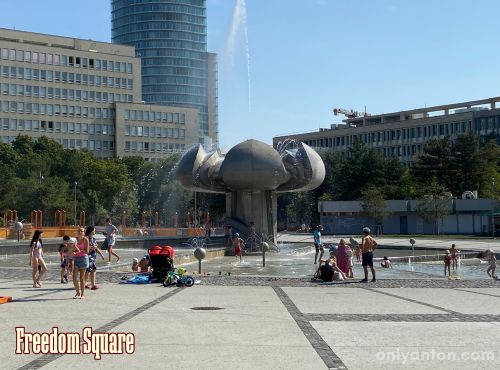
Freedom Square and University Buildings
Located near Slovenská Technická Univerzita, Freedom Square is surrounded by architecture emblematic of Soviet-era design. The University buildings are decorated with relief sculptures. These relief panels depict various trades and sciences, symbolic of Communist ideals celebrating labour and industry. The square itself, once used for Communist rallies, serves as a reminder of Bratislava’s ideological past. The strong lines, concrete surfaces, and heavy proportions are classic Brutalist elements. Together, they convey a sense of utilitarianism and collective purpose.


First Prefab Building and Stein Brewery Building
Not far from the iconic Brutalist structures of Bratislava stands the first prefab building in Slovakia, a symbol of Soviet-era architectural innovation. This building, constructed in 1955, represents the early adaptation of prefabricated methods in Slovak housing, marking a shift toward streamlined construction during the Communist period. Nearby is the former Stein Brewery, an industrial complex dating back to 1872 and now a local architectural landmark. While not Brutalist, the brewery’s Spilka building, with its distinctive dome, adds historic character to the area. Repurposed as the Spilka Offices, it showcases a thoughtful blend of preservation and modern use, echoing Bratislava’s ability to bridge the old and the new. Together, these two buildings highlight the architectural diversity that makes this part of the city particularly fascinating.
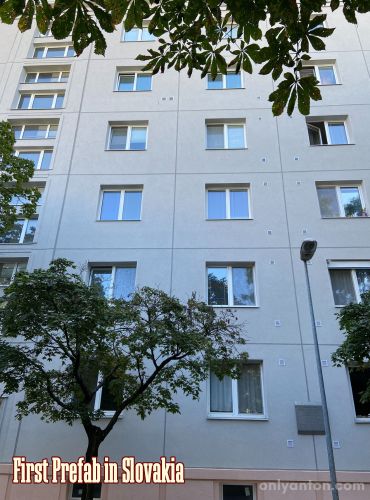

Petržalka Housing Estate
Across the Danube, Petržalka stands as one of Europe’s largest socialist housing projects. It was intended to provide affordable housing for Bratislava’s growing population. The estate consists of vast, concrete-panel buildings arranged in a grid pattern, stretching for miles. Its scale is impressive and overwhelming, reflecting the ideals of socialist urban planning. Originally built to embody the Communist values of collective living, Petržalka has since undergone redevelopment. Today, it’s a lively residential area. It remains a quintessential example of Soviet-era mass housing, showcasing the Brutalist emphasis on functionality over beauty.

SNP Square and Market Hall
The Slovak National Uprising (SNP) Square is historically significant, commemorating Slovakia’s resistance against Nazi occupation in WWII. During the Communist era, it became a focal point for Soviet events and rallies. Nearby, the Market Hall, with its stark, utilitarian design, is a reminder of Bratislava’s Soviet past. Together, these sites encapsulate the era’s aesthetic values and political significance. Though the buildings may seem plain by modern standards, they hold deep cultural resonance as symbols of Slovakia’s journey through a turbulent period of history.
Personal Reflection: Insights from the Post-Communism Tour
Experiencing Bratislava’s Soviet-era Brutalist architecture is more than just viewing buildings. It’s an exploration of the city’s historical and cultural layers. On the Post-Communism Tour, I had the chance to ride in a vintage Skoda. The local expert guide offered fascinating insights into daily life during the Communist period. Seeing the imposing architecture while hearing about life behind the Iron Curtain made the experience even more vivid. My guide shared stories about rationing, long lines for basic goods, and the tightly controlled social environment. As we stopped to discuss and admire the various structures, the architecture began to feel like a silent witness to the era’s challenges and ideologies. It was eye-opening to understand these structures as more than concrete giants. They are also symbols of resilience and adaptation in a society once shaped by strict government control.
Practical Tips
For travellers intrigued by Soviet history and architecture, a guided tour is invaluable for appreciating the full context of Bratislava’s Brutalist landmarks. Authentic Slovakia’s Skoda Tour is a unique way to see these sites, providing insightful commentary and a touch of nostalgia. Tours often include visits to the Slovak Radio Building, Petržalka, and other Soviet-era landmarks that are not typically covered in standard tourist itineraries. These tours are a fantastic option for anyone seeking a deeper understanding of Bratislava’s complex architectural landscape and the lived experiences of its residents during the Communist period.
Section III: Experiencing Slovak Cuisine
Slovak cuisine is a reflection of the country’s landscapes and history, shaped by the hearty ingredients that thrive in its mountainous terrain and the culinary influences of neighbouring countries like Hungary, Austria, and the Czech Republic. Slovak food is warm, filling, and deeply satisfying—a cuisine designed for cold winters and long days. Typical dishes are rich in potatoes, cabbage, pork, and dairy, all brought together in comforting recipes passed down through generations. Slovak cuisine might share certain flavours with its Central European neighbours. Regional touches, however, make it unique and a memorable experience for travellers.
Dining Highlights
Koliba Kamzik
For an authentic taste of Slovak cuisine in a rustic setting, Koliba Kamzik in the Old Town is a must-visit. Styled as a traditional Slovak koliba or shepherd’s hut, this restaurant captures the charm and warmth of the countryside. From the moment I walked in, the comforting scent of smoked meats and savoury herbs enveloped me. My meal began with a local specialty—garlic soup with smoked cheese and an herb omelette. The rich flavours and aroma made it a perfect start, especially after a day of exploring. For the main course, I opted for the Kamzik plate, a sampling of Slovak classics. It featured bryndza pierogies, potato gnocchi with bryndza (a tangy sheep’s milk cheese), gnocchi with sauerkraut, sausage, bacon, sour cream, and chives. The flavours were robust and satisfying, each bite a testament to the care that goes into traditional Slovak cooking.

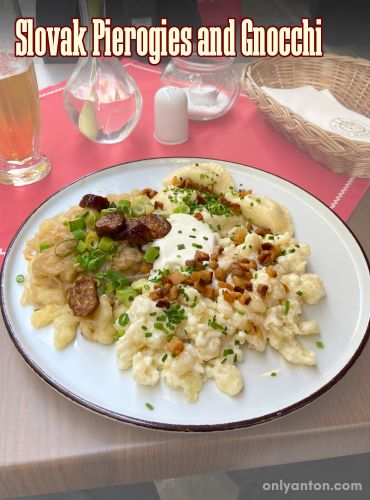
Slovak Specialties
Slovakia’s national dish, halušky, is a must-try for any visitor. These soft, potato-based dumplings are smothered in bryndza cheese. They are often topped with crispy bits of bacon, offering a savoury, creamy, and slightly tangy flavour profile. Another staple is kapustnica, a hearty cabbage soup usually made with smoked meat, sauerkraut, and mushrooms. This soup is especially popular during the winter months and at Christmas, providing a comforting taste that captures the essence of Slovak home cooking. For something lighter, lokše, or potato pancakes, are a versatile dish served savoury with duck or sweet with poppy seeds or jam. Each dish is simple in ingredients but rich in flavour, embodying the “less is more” philosophy of Slovak cooking.


Local Beverages
Slovak beer is an essential part of the dining experience, with a growing craft beer scene and traditional lagers that pair beautifully with the local food. Beers like Zlatý Bažant are popular choices, providing a refreshing contrast to the hearty flavours of Slovak dishes. For those looking to try something stronger, Tatratea is a unique herbal tea liqueur, traditionally enjoyed as a warming drink. Originating in the High Tatras mountains, Tatratea has various strengths and flavours, from fruity to spiced, and has become a symbol of Slovak hospitality. A softer option is Kofola, a local cola alternative with a distinctive, slightly herbal taste that dates back to the Communist era. Kofola’s flavour is less sweet than Western sodas, with a hint of anise, making it an exciting taste experience for the adventurous traveller.
Personal Tips
Those wanting to dive into Slovak cuisine should visit the Old Town. This city area is filled with traditional eateries where you can savour everything from local dumplings to grilled sausages. Venturing into the city’s markets is another excellent way to experience the local flavours. Here, you’ll find fresh produce, cured meats, and baked goods, often with friendly vendors eager to share their food and stories. While Bratislava offers many traditional options, you’ll also find innovative restaurants that put a modern twist on Slovak classics. Whether it’s halušky with a new flavour profile or creative takes on traditional desserts, these culinary fusions highlight how Slovak food continues to evolve.
Cultural Note: Food is central to Slovak festivals and celebrations, creating a sense of connection and community. Dishes like kapustnica and halušky are often prepared in large quantities for gatherings, bringing family and friends together over shared meals. The importance of hospitality is deeply embedded in Slovak culture, and sharing a meal is one of the most genuine ways to connect with locals. As you explore Slovak cuisine, you’re not just tasting food—you’re experiencing a slice of Slovak tradition that continues to shape the country’s identity and spirit.
Section IV: A Journey to Slavín War Memorial
Overview of Slavín
The Slavín War Memorial is one of Bratislava’s most significant historical landmarks. It is a solemn tribute to the Soviet soldiers who lost their lives liberating the city from Nazi occupation during World War II. Built between 1957 and 1960, Slavín serves as a cemetery and a towering monument, honouring the nearly 7,000 soldiers buried here. Its prominent location on a hill overlooking Bratislava gives it a distinct presence in the city’s landscape. It is a powerful reminder of the region’s complex history and the sacrifices made during a tumultuous era.

Description and Reflection
The memorial is an imposing structure. The central obelisk rises to over 39 meters with a statue of a Soviet soldier holding a flag in victory. The atmosphere around Slavín is both sombre and awe-inspiring. Rows of gravestones line the hillside, and commemorative plaques are dedicated to various Soviet regiments. The quiet, verdant surroundings give the memorial an almost tranquil feeling, with well-maintained gardens and trees framing the area.
From Slavín’s vantage point, visitors are treated to panoramic views of Bratislava, extending across the Danube to the Petržalka district and beyond. This bird’s-eye perspective over the city highlights the contrast between the Soviet-era aesthetic of Slavín and Bratislava’s evolving identity, blending history with modernity. For many Slovakians, Slavín holds deep significance as both a historical site and a place of reflection, marking a pivotal moment in the city’s past. The juxtaposition of this Soviet monument with the dynamic, independent spirit of modern Slovakia adds an extra layer of poignancy to a visit, evoking a sense of respect for history and remembrance.
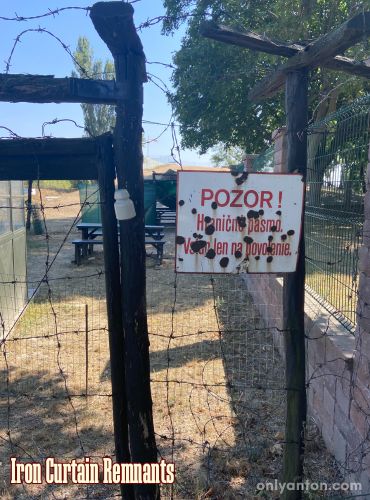
In addition to Slavín, visitors interested in Bratislava’s more recent history may wish to explore the Iron Curtain remnants on the city’s southern edge. Located beyond the Danube and Petržalka’s vast housing estates, this former border zone is a stark reminder of the Cold War divide that once separated Eastern and Western Europe. Visitors can find traces of rusted fences, disused bunkers, and informational markers detailing Bratislava’s position on the Iron Curtain. This sobering site offers a fascinating counterpoint to the Slavín Memorial, bridging WWII’s legacy with Bratislava’s role in the tense years of Soviet influence during the Cold War.
Practical Tips
Slavín is accessible by public transport, with several bus lines reaching the area from the city centre, or visitors can enjoy a scenic walk up the hill. For those interested in Bratislava’s layered history, pairing a visit to Slavín with a trip to the Iron Curtain border zone provides a comprehensive perspective on the city’s Soviet-era experience. Early mornings or late afternoons are ideal for visiting Slavín, especially if you seek solitude. Bring comfortable walking shoes for the hilly paths, and pause at the viewpoints for a quiet moment to absorb the city’s history and the powerful symbolism of these memorial sites.
Section V: Practical Tips for Visiting Bratislava
Best Time to Visit
Bratislava is a year-round destination, though the experience varies by season. Summers are usually pleasant in the mid to high 20s Celsius (70-80°F), but temperatures have risen as high as the 40s Celsius. Summer is ideal for wandering the Old Town and enjoying outdoor cafés. Many Bratislavians take a holiday in the summer, so traffic and crowds are often light. Winters can be chilly, frequently dipping below freezing, but Bratislava’s holiday markets and festive lights bring a cozy charm that makes it worth a winter visit. Spring and early autumn are perhaps the best times to visit, with comfortable temperatures and fewer tourists.
Getting Around
Bratislava’s compact size makes it perfect for exploring on foot, especially within the picturesque Old Town, where you’ll find historic sites, cafés, and hidden courtyards. For destinations further afield, Bratislava’s tram and bus system is reliable and easy to navigate. Tickets are available at kiosks or via mobile apps, and they cover both trams and buses, making it convenient to reach places like Slavín or the Petržalka district.
Language and Cultural Tips
Though many Slovakians, especially younger generations, speak English, learning a few Slovak phrases can go a long way in connecting with locals. Try saying “Dobrý deň” (Good day) for a polite greeting, “Ďakujem” (Thank you), and “Prosím” (Please/You’re welcome). Remember that Slovakians value politeness and respect, so greet shopkeepers and servers with a friendly “hello” and consider saying “na zdravie” (cheers) when clinking glasses with new friends.

Recommended Tours and Guides
A local tour can be invaluable for those interested in understanding Bratislava’s unique blend of history, culture, and architecture. The Authentic Slovakia Skoda Tour offers insights into the city’s post-Communist history and Soviet-era architecture while riding in a vintage Skoda car. This tour goes beyond the typical tourist attractions, providing a deeper look into Bratislava’s history through the eyes of locals.
Conclusion
Bratislava may often be overlooked in favour of its larger neighbours, Vienna and Budapest, but Slovakia’s capital has a charm all its own. From the timeless streets of the Old Town to the striking Brutalist structures that echo its Soviet past, Bratislava offers a compelling mix of history, architecture, and culture that surprises and delights travellers. Add to this the warmth of Slovakian hospitality, the hearty flavours of local cuisine, and views from the iconic UFO Bridge, and you have a destination that rewards those willing to explore beyond the usual stops. Whether you’re captivated by medieval history, fascinated by Soviet architecture, or simply looking to sample authentic Slovak dishes, Bratislava promises a journey rich in experiences.
What About You?
Have you been to Bratislava, or is it on your travel list? I’d love to hear about your favourite spots, surprising encounters, or memorable moments from your visit to this unique city. Have you explored Brutalist architecture or tried Slovakian dishes like halušky and Tatratea on your travels? Share your stories, tips, and recommendations in the comments below!
If you’re intrigued by Bratislava, why not consider exploring more of Eastern Europe’s hidden gems? This region is filled with rich history, unique architecture, and diverse cultural experiences waiting to be discovered. Let’s keep the conversation going and inspire one another’s journeys!
Further Reading and Resources
Related Posts on Only Anton
- Aachen Travel Guide: Discover Aachen, a hidden European gem with rich history, unique cultural experiences, and vibrant culinary delights.
- Best Things to Do in Prague: History, Culture, and Dining: Discover the best things to do in Prague, from historic sites to local cuisine. Find valuable travel tips in this must-read guide.
External Resources
These resources provide an in-depth look at Bratislava’s history, architecture, and cultural landscape, perfect for travellers eager to explore more.
Books and Articles
- Rick Steves Central Europe: The Czech Republic, Poland, Hungary, Slovenia & More (2023) by Rick Steves and Cameron Hewitt: A practical travel guide covering Central Europe’s cultural highlights, cities, and essential tips for exploring Bratislava and neighbouring countries. Borrow it from a library, look for it online, or get a copy here.
- A History of Slovakia: The Struggle to Survive (2nd ed., 2005) by Stanislav J. Kirschbaum: A comprehensive overview of Slovakia’s complex history, from its early origins through the 20th-century challenges and modern developments. Discover it at your library, look it up online, or purchase your own copy here.
- Soviet Modernism, Brutalism, Post-Modernism: Buildings and Projects in Ukraine 1960-1990 (2019) by Oleksiy Bykov and Ievgeniia Gubkina: An exploration of Soviet architectural styles in Ukraine, highlighting projects that share cultural and stylistic connections with Bratislava’s Brutalist heritage. Locate it at a library, check online options, or purchase it here.
- Atlas of Brutalist Architecture: Classic Format (2020) by Phaidon Editors: An illustrated compendium featuring significant Brutalist structures worldwide, including Central Europe’s distinctive post-war architecture. See if your library has it, look online, or snag a copy here.
- “Iconic Buildings of Bratislava” by the Bratislava Tourist Board: An online guide showcasing Bratislava’s most famous architectural landmarks, offering insight into the city’s diverse styles and historical influences. Read the article online here.
Websites
- Authentic Slovakia’s Post-Communism Tour: A unique tour exploring Bratislava’s Soviet-era architecture and history, perfect for a deeper understanding of the city’s past.
- Koliba Kamzik Restaurant, Bratislava: Traditional Slovak restaurant in the heart of Bratislava’s Old Town.




